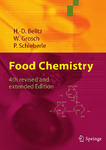| dc.description.abstract | The very rapid development of food chemistry and technology over the last two
decades, which is due to a remarkable increase in the analytical and manufacturing
possibilities, makes the complete lack of a comprehensive, teaching or reference
text particularly noticeable. It is hoped that this textbook of food chemistry will
help to fill this gap. In writing this volume we were able to draw on our experience
from the lectures which we have given, covering various scientific subjects, over
the past fifteen years at the Technical University of Munich.
Since a separate treatment of the important food constituents (proteins, lipids, carbohydrates,
flavor compounds, etc.) and of the important food groups (milk, meat,
eggs, cereals, fruits, vegetables, etc.) has proved successful in our lectures, the subject
matter is also organized in the same way in this book.
Compounds which are found only in particular foods are discussed where they
play a distinctive role while food additives and contaminants are treated in their
own chapters. The physical and chemical properties of the important constituents
of foods are discussed in detail where these form the basis for understanding either
the reactions which occur, or can be expected to occur, during the production,
processing, storage and handling of foods or the methods used in analyzing them.
An attempt has also been made to clarify the relationship between the structure and
properties at the level of individual food constituents and at the level of the whole
food system.
The book focuses on the chemistry of foodstuffs and does not consider national
or international food regulations. We have also omitted a broader discussion of
aspects related to the nutritional value, the processing and the toxicology of foods.
All of these are an essential part of the training of a food chemist but, because of the
extent of the subject matter and the consequent specialization, must today be the
subject of separate books. Nevertheless, for all important foods we have included
brief discussions of manufacturing processes and their parameters since these are
closely related to the chemical reactions occurring in foods.
Commodity and production data of importance to food chemists are mainly given
in tabular form. Each chapter includes some references which are not intended
to form an exhaustive list. No preference or judgement should be inferred from the
choice of references; they are given simply to encourage further reading. Additional
literature of a more general nature is given at the end of the book. | en_US |

